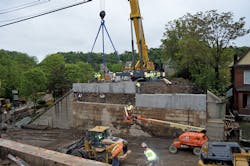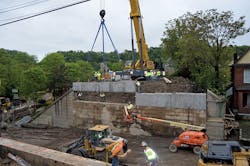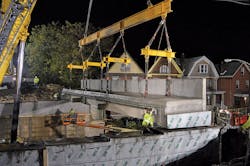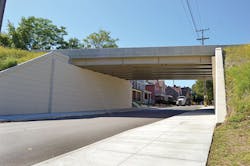A modern crossover
The reinforced concrete T-beam bridge on U.S. Rte. 30 over Bessemer Avenue in East Pittsburgh, Pa., had served the area well since 1937.
But more than 80 years of traffic and weather had taken its toll. The bridge was structurally deficient to the point that workers had to install temporary shielding underneath the bridge structure because concrete was falling onto the roadway and sidewalks below.
The dense urban area sees pedestrians passing under the bridge every day as most of the community is on one side of it and a bus stop is on the other. From any perspective, the time had come for a replacement.
HNTB Corp. was the prime consultant on the project and provided preliminary engineering, final design and construction support services.
Replacement of the superstructure, in theory, seemed simple. Reality proved to be the opposite. The neighborhood is busy. U.S. Rte. 30 is a critical route and the traffic load is heavy. Closing the bridge for complete reconstruction would take months, and any detour that officials considered was prohibitively lengthy.
The team had to remove a portion of the abutment because the deterioration had extended below the bridge seat. This added several hours to the project. Photo courtesy of HNTB.
ABC to the rescue
Pennsylvania Department of Transportation (PennDOT) officials knew conventional bridge construction was not a favorable solution. Accelerated bridge construction (ABC) quickly rose to the top of available methods to get a new bridge in place. With the need for speed apparent, PennDOT and HNTB began evaluating the bridge and selecting alternatives.
“This bridge was essentially a poster child for ABC,” said Robert Bistline, P.E., HNTB vice president and project manager. “ABC made perfect sense for replacing it. It limits impacts to traffic. It reduces the time a contractor needs to be in the field building the bridge. Motorists are affected for a shorter duration than they would be otherwise. Plus, this was a very tight construction site, and to have on-site construction would have been unsafe for workers and motorists. ABC eliminates hazards to both, since the bridge is built away from traffic. In this instance, the entire bridge was prefabricated in a relatively safe shop environment.”
Plans eventually called for ABC to be used to replace the bridge in an unimaginable timeframe—57 hours between Friday, May 20, to early Monday, May 23, 2016.
“We needed speed,” said Bala Sivakumar, P.E., HNTB director of special bridge projects. “This is not a big bridge, but there was complexity because it is on a curve. This, compounded by the tight timeframe, made it a challenging project. Fifty-seven hours is not a lot of time to demolish a bridge and build a new one. Making it more challenging was that we had to remove a portion of the abutment, or substructure, because the deterioration had extended below the bridge seat.
“This added several hours to the critical path of the project, meaning that if this single task got delayed, everything else would get delayed and jeopardize on-time project completion,” he added.
Plans for the U.S. Rte. 30 bridge over Bessemer Avenue called for ABC to be used to replace the structure in a 57-hour timeframe over one weekend. Photo courtesy of HNTB.
Innovation guides implementation
With a promise to the driving public of a single weekend closure, PennDOT, HNTB and contractors left nothing to guesswork. Things had to go as planned the first time around. Work in the design phase helped ensure this was achieved.
The team relied upon innovative construction practices that support ABC. They included:
- Concrete core and testing—Concrete cores from existing abutments were tested for chloride content, cracking and general deterioration to verify the suitability of the existing abutments to be cut to receive the precast bearing seats. This was critical to ABC to reduce risk to PennDOT should unanticipated conditions be encountered during construction;
- Prefabricated bridge elements—All bridge elements were built before being moved to the field;
- 3-D model verification—LIDAR surveys during the final design phase located the features of the bridge, overhead utilities and adjacent residences. This information was used to create a 3-D model, which represented existing site conditions and bridge elements. Designers used the model to verify crane operations and bridge constructability;
- Approach slabs—The approach slabs were designed and detailed to carry traffic without fill beneath them. The slabs spanned from the paving notch in the concrete end diaphragm to the sleeper slab at the far end of the approach slab. This allowed the bridge to open to traffic prior to backfilling behind the abutments. It was later completed using flowable fill poured through openings cast in the approach slabs;
- Ultra-High-Performance Concrete (UHPC)—HNTB worked with PennDOT to specify the latest UHPC material available. The accelerated-cure UHPC used was capable of achieving a compressive strength of 12,000 lb per sq in. (ksi) within 12 hours after placement. It also was used to connect all prefabricated bridge components, critical to meeting the 57-hour schedule. Designers also met with PennDOT staff to discuss lessons learned/best practices from a previous project; and
- Detailed micro-schedule—A detailed construction schedule was compiled for the entire weekend. It validated the feasibility of the aggressive approach and provided confidence to the team that project goals were achievable.
The micro-schedule is critical to the design team, the contractor and other team members.
“Typically, on a weekend replacement project like this, we put together an hourly, or engineer’s schedule,” Sivakumar said. “When contractors come on board, they often create a more detailed schedule, sometimes down to 15-minute intervals. They often improve upon our schedules.”
Sivakumar said these schedules ensure that everyone understands the sequence of events, what must get done and how much time is allowed to meet the deadline. Micro-schedules also are good tools to monitor progress so that if one crew is an hour behind, they can find a way to expedite things to stay on schedule, even if it means adding more workers.
The installation
The big weekend arrived, and teams went to work.
“The abutment replacement added several hours to the project,” Sivakumar said. “It was on the critical path, which means that if any part of this got delayed, everything else would also get delayed. It was a crucial element.”
A rainstorm added to the team’s challenges, but precautions ensured progress continued as originally planned. Because of the LIDAR use, power lines above the bridge stayed in place, eliminating much utility relocation work. The workflow proceeded in part because of the strong partnership HNTB, PennDOT and contractors forged early on.
“ABC projects have challenges that are unique to this type of construction,” Sivakumar said. “We make it a point to ensure early on that all parties can work hand-in-hand. Plus, we make sure key personnel are available.
“For instance, during this closure, we had our designers on-site with the contractor and PennDOT from start to finish,” he added. “Often, we have multiple engineers on-site. There are many complex decisions to be made on the spot. It is helpful for the contractor to hear from the owner’s representative, the designer and others, and know they’ll be on-site throughout the super weekend, as we call it.”
This formula worked. The bridge was installed on time, generating little motorist concern.
“From the beginning we had a good design,” said Cheryl Moon-Sirianni, PennDOT District 11 district executive. “The schedule was well-planned and we had a contractor who was organized and had the resources required to complete a project of this magnitude and within the tight timeframe. He even had his own precast facility. We had all the arrows pointing in the right direction for this project to be successful from the onset.”
The U.S. Rte. 30 bridge sits in a dense urban area where pedestrians pass under the structure every day as most of the community is on one side of the bridge and a bus stop is on the other. Photos courtesy of Tri-State Design & Development.
A major win
The on-time delivery proved that ABC works. It also demonstrated that the team at PennDOT District 11 is deploying ABC effectively. They have identified situations where ABC makes sense and have discovered the driving public likes ABC as much as they do.
“We’ve been using ABC when detours are going to be 7 miles or longer,” said Louis Ruzzi, P.E., District 11 bridge engineer. “We’ve not encountered a bad project yet. This one confirmed the effectiveness of ABC even more so. It was a significant project that resulted in little negative feedback.”
This lack of public response indicates success to PennDOT.
“As far as ABC projects go, motorists love them because they are inconvenienced a short amount of time,” Moon-Sirianni said. “In the age of social media, the public is quick to let us know when they’re displeased with a project. Rightfully, they expect to travel from point A to point B with little or no disruption. So, when we can deliver a bridge over a weekend on a project like this and receive little or no comment, we know we’re meeting their expectations.”
Ruzzi concurred, adding that the public is aware of ABC now more than ever. The Pennsylvania Turnpike recently completed a highly publicized ABC project that helped make even more drivers aware of the process. Ruzzi said the questions now are more in the direction of, “Why can’t you do this everywhere?”
A higher awareness has been noted by industry peers. PennDOT and HNTB were honored with a Diamond Award for Engineering Excellence in 2017 by the American Council of Engineering Companies of Pennsylvania in the special projects category. In addition, the project received the Best ABC Project Award in the PBES category during the National ABC Conference in December 2017.
The frequency of ABC may increase in District 11 if Moon-Sirianni and Ruzzi continue following their prescription. In addition to the length of detour consideration, Moon-Sirianni said getting the right partnership in order is critical.
“Collaboration and partnership are the most important things to Lou (Ruzzi) and me,” she added. “We look for consultants to bring us innovation, but we want to be sure they’ve implemented them in the past. These projects are relatively high-risk, but the rewards for motorists and taxpayers can be high. That’s why partnership is so critical to achieve success.”
This cooperation helped keep a neighborhood together and heavy commuter traffic flowing by safely and efficiently restoring the bridge over Bessemer Avenue. In fact, the project improved it by creating an additional 3 ft of vertical clearance underneath, which allows for unrestricted access.
Because ABC was used, local businesses and commuters were not adversely affected, and transit service continued to surrounding neighborhoods with minimal rider inconvenience.
As it rushed to completion, this project demonstrated how the seamlessness of ABC can be as effective on a single-span bridge woven tightly into a community as on a multi-lane bridge on a high-capacity freeway.




